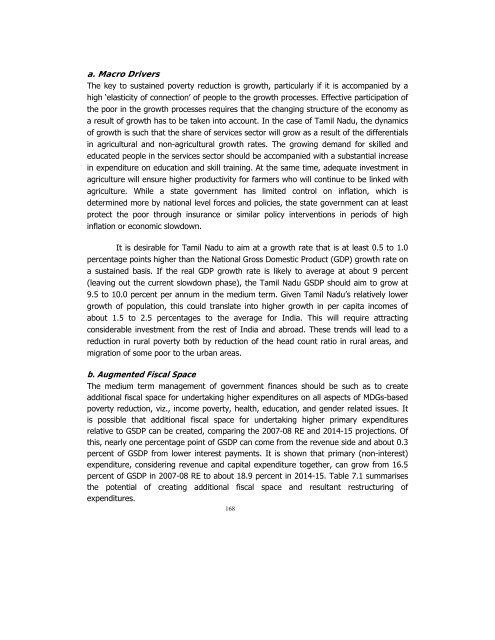POVERTY REDUCTION STRATEGY TN
You also want an ePaper? Increase the reach of your titles
YUMPU automatically turns print PDFs into web optimized ePapers that Google loves.
a. Macro Drivers<br />
The key to sustained poverty reduction is growth, particularly if it is accompanied by a<br />
high ‘elasticity of connection’ of people to the growth processes. Effective participation of<br />
the poor in the growth processes requires that the changing structure of the economy as<br />
a result of growth has to be taken into account. In the case of Tamil Nadu, the dynamics<br />
of growth is such that the share of services sector will grow as a result of the differentials<br />
in agricultural and non-agricultural growth rates. The growing demand for skilled and<br />
educated people in the services sector should be accompanied with a substantial increase<br />
in expenditure on education and skill training. At the same time, adequate investment in<br />
agriculture will ensure higher productivity for farmers who will continue to be linked with<br />
agriculture. While a state government has limited control on inflation, which is<br />
determined more by national level forces and policies, the state government can at least<br />
protect the poor through insurance or similar policy interventions in periods of high<br />
inflation or economic slowdown.<br />
It is desirable for Tamil Nadu to aim at a growth rate that is at least 0.5 to 1.0<br />
percentage points higher than the National Gross Domestic Product (GDP) growth rate on<br />
a sustained basis. If the real GDP growth rate is likely to average at about 9 percent<br />
(leaving out the current slowdown phase), the Tamil Nadu GSDP should aim to grow at<br />
9.5 to 10.0 percent per annum in the medium term. Given Tamil Nadu’s relatively lower<br />
growth of population, this could translate into higher growth in per capita incomes of<br />
about 1.5 to 2.5 percentages to the average for India. This will require attracting<br />
considerable investment from the rest of India and abroad. These trends will lead to a<br />
reduction in rural poverty both by reduction of the head count ratio in rural areas, and<br />
migration of some poor to the urban areas.<br />
b. Augmented Fiscal Space<br />
The medium term management of government finances should be such as to create<br />
additional fiscal space for undertaking higher expenditures on all aspects of MDGs-based<br />
poverty reduction, viz., income poverty, health, education, and gender related issues. It<br />
is possible that additional fiscal space for undertaking higher primary expenditures<br />
relative to GSDP can be created, comparing the 2007-08 RE and 2014-15 projections. Of<br />
this, nearly one percentage point of GSDP can come from the revenue side and about 0.3<br />
percent of GSDP from lower interest payments. It is shown that primary (non-interest)<br />
expenditure, considering revenue and capital expenditure together, can grow from 16.5<br />
percent of GSDP in 2007-08 RE to about 18.9 percent in 2014-15. Table 7.1 summarises<br />
the potential of creating additional fiscal space and resultant restructuring of<br />
expenditures.<br />
168

















